The stunning scenes on the mural at Center Ridge Road and Route 83 synopsize Ridgeville
Township’s founding. They were painted by North Ridgeville High School seniors to honor
the Ridgeville Bicentennial. Teacher Jim Messenheimer was the artistic director. José Leal and
Colton Ulrich were the student art directors. The historical advisor was Alan Willoughby, aka
David “Grandpa” Beebe, of the North Ridgeville Historical Society.
The City of North Ridgeville, the North Ridgeville Historical Society and North Ridgeville City
Schools are deeply grateful to the sponsors who made this mural possible: The Beckett
Companies (the primary mural sponsor), Don Mould’s, Ohio RDC and Sherwin-Williams.
We also appreciate the generous support of Buescher’s True Value Hardware, D&D Moving
and Storage, and The Eclectic Tattoo Company.
Parking: Enjoy the mural close up. Parking is available any time at Eclectic Tattoo (on Route
83) or at the Old Town Hall (just 100 yards west on Center Ridge Road). Or park in the
smaller lot at Buescher’s Hardware during non-business hours.
The artistry: The toughest artistic decisions involved the balance between truth and beauty
and between truth and clarity. In full foliage, the high forest canopy was so dense that it hid
the sky and the view below was “dismal.” Scenes of the Bachelors’ Camp and Center
Ridge chose different truth-beauty balance points. The river valleys were full of forest and
dense under growth. On center ridge, “the eye could not penetrate” this under growth. If
painted realistically, three scenes would be just a jumble of greens and browns. Viewers
would not see what was happening.
The student artists were inspired by Ridgeville’s unique history. In turn, we all can be
inspired by their talents and their efforts under very tight constraints.
The six scenes appear in chronological order, the first three in the spring of 1810, and the
last three that fall.
Student artists: Sara Baird, Ashley Baker, Paul Dregalla, Chris Fule, Nicole Fraley,
Ian Guevara, Emily Hanson, Rheanna Johnson, Jessica Keaton, José Leal, Kara Malcolm,
Mitchell Mathis, Ryanne O’Dee, Colin Olivia, Nick Penner, Justin Regal, Kelsey Rogers,
Kaitlin Schneider, Jessica Schroeder, David Thomas, Jr., Devin Thomas, Colton Ulrich,
Claudia Willis.
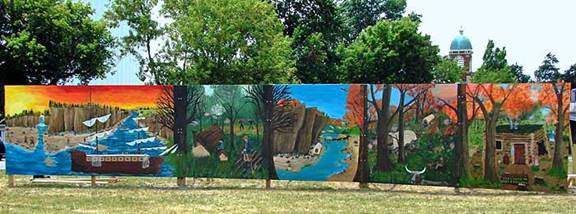
The Ridgeville History Mural
Erected July 2010
At the corner of Center Ridge Road and Route 83 (Avon-Belden Road)
The tower of the historic Old Town Hall rises behind on the right.
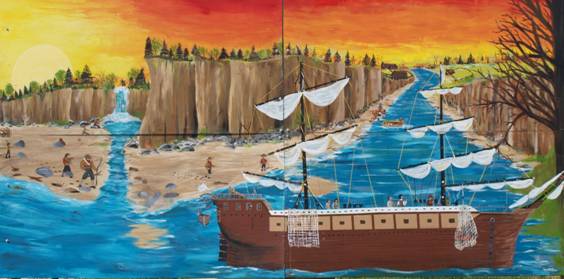
Hiking the Beach
Late April 1810
(Left end of mural)
Artists: Chris Fule, Nicole Fraley, Kara Malcolm, Nick Penner, Colton Ulrich
When our pioneers hiked the 600+ miles from Waterbury, Connecticut, to Ridgeville with
their supplies on their backs, a third of their journey was along the broad, virtually continuous
beach of Lake Erie. The beach was the only through road. Ice remnants were still on the lake
each April. Many creeks and rivers cut through the beach. A sandbar was usually present at
each one.
This scene shows fourteen pioneers continuing along the beach at a typical creek
crossing. But the viewer cannot feel their fatigue from backpacking a marathon a day for
weeks on end. And the viewer cannot feel their bone-chilling wetness from eight days of
crossing cold creeks in a brisk north wind coming across a frigid lake.
Within a couple more decades the beach highway was destroyed. Because of the white
man’s hard structures at the shoreline, the lake currents rearranged the beach sands differently.
Rendezvous at Cleaveland
May 1810
(Right half of shoreline scene above)
Artists: Paul Dregalla, José Leal,
David Thomas, Jr., Devin Thomas
The heavy farm tools that our pioneers bought at Buffalo were put on board a ship and
guarded by Lyman Root. Favored by the winds, probably north winds, the ship arrived
at Cleaveland in only seven days. This was one day before Lyman’s fellow workmen
arrived on foot. The boat they hired was definitely a sailing vessel, as steam power was
not yet on Lake Erie. This unknown vessel may well have been smaller and less sleek than
the one depicted, which is like Oliver Perry’s Niagara.
The Cuyahoga River mouth was blocked by a large sand bar. All lake craft had to moor
outside the river. This scene shows their shipment being rafted across this shallow
obstacle into the river, using poles.
A majestic view could be had from high on the cliff where a small and struggling
Cleaveland was perched. But the river mouth was cluttered with limbs and vegetation
from the spring floods. Feel relieved that the artists could not recreate the stench from
the decaying vegetation.
After the fourteen walkers met with Lyman and their cargo, some went twenty miles
south to Columbia to borrow pack animals from their kinfolk. With this help, they
hauled the heavy items to Columbia.
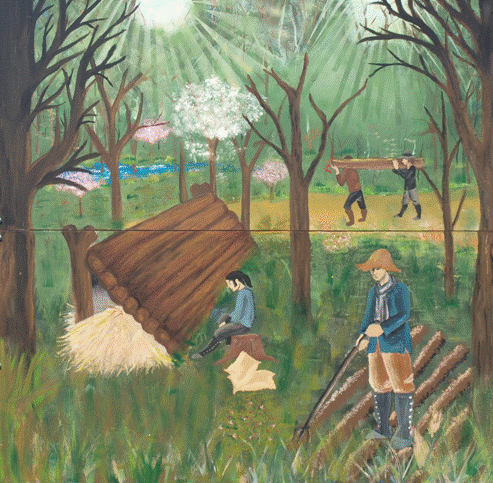
The Bachelors’ Camp
May 1810
Artists: Sara Baird, Emily Hanson,
Rheanna Johnson, Kelsey Rogers
After celebrating and recuperating at Columbia, our fifteen pioneers were joined by three
others already in Columbia since mid 1809. On May 10, 1810 they carried whatever
they could on their backs, up the narrow and sometimes swampy Indian trail (now Root
Road) into their new township (Twp16-6).
They named Butternut Ridge and Chestnut Ridge for the prevalent trees. They named
the township “Rootstown,” in honor of Ephraim Root. They had given Mr. Root their
Connecticut lands in exchange for first choice of over a quarter of the new township.
Before choosing their permanent farms, they set up a work camp. This scene depicts
the early stages of building this “bachelor camp.” They promptly cleared two
acres for crops and built a “bachelors’ cabin.” This structure was built using “crotches,
” Y-forked young trees. It was a cross between a wooden tent and a normal log cabin.
It had a bark roof and was large enough to sleep eighteen on its dirt floor, on leaves at
first. A fire outside the open end kept out mosquitoes and wild life.
During the summer of 1810 they operated out of the bachelor camp as they cleared four
farms and worked on four more cabins. In early July, Tillotson Terrell brought his wife,
Electa, and three young children to live in the bachelor cabin as he built their cabin. His
family was Ridgeville’s first settlers. Weekly supplies were still brought in on their backs,
but on a shortcut road they were building to Columbia. It was a couple years until this
“Old Mud Road” became wide enough for a wagon. It was rarely dry enough.
Late in the fall of 1810, the bachelor cabin would become a winter residence for Noah
Terrell’s family. We presume that the open end was closed before winter, and that the
cabin was chinked to shut out the winds.
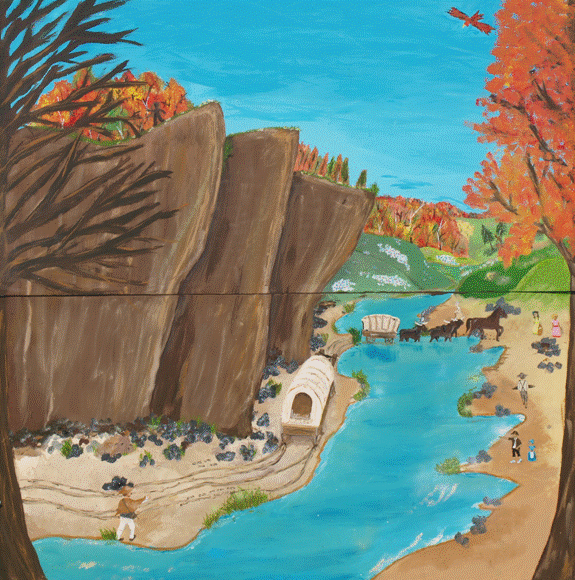
Fording the Rocky River
October 1810
Artists: Ashley Baker, Ian Guevara,
Ryanne O’Dee, Colin Olivia
Because farm clearing and cabin building had progressed so well, David Beebe, Jr.,
walked back to Waterbury, CT, to lead the families west to Ohio. Their two ox-drawn
wagons were each led by a horse. Riders included six women and twelve young children.
Four men provided the necessary human muscle for working the wagons out of trouble.
Asa Morgan assisted part way to get them past the hazardous Cattaraugus Creek.
This scene shows the wagons on the new route that Beebe had wisely chosen from
Cleaveland to Rootstown. He took them along the Lake Erie beach to the Rocky River;
then up the river valley to where it meets the current Center Ridge Road. Most likely, they
were the first wagons ever there. Whether or not they traveled in the company of other
travelers before, they were clearly alone beyond Cleaveland.
Wagoners preferred to cross rivers where they were wide, shallow and slower flowing;
not narrow, deep and fast. When there was a risk of a wagon turnover, people and
precious cargo were ferried across first. Sometimes extra oxen were hitched to each
wagon for a surer easier crossing. The valley was actually full of forest. But if it had
been painted in, the viewer would not be able to see the wagons from this vantage point.
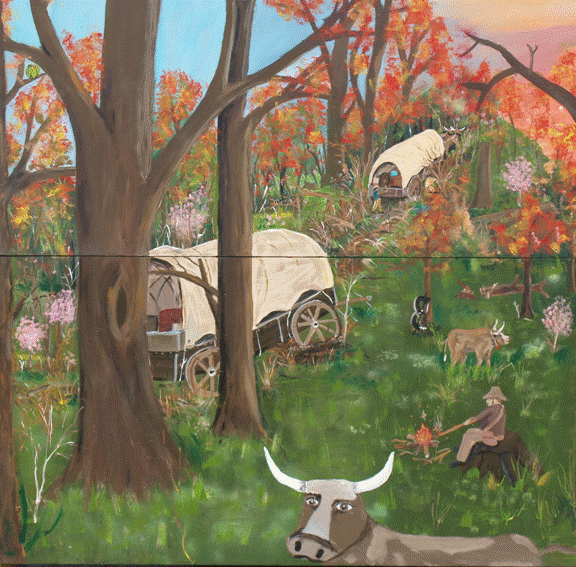
Clearing the Center Ridge
October 1810
Artists: Mitchell Mathis,
Justin Regal, Kaitlin Schneider
Where Center Ridge Road now stands there was only a winding Indian trail on the floor
of the forest. So dense in places was the underbrush of scrub oak and green briar that
even the eye could not penetrate it.
The women and young children were temporarily quartered at an inn (cabin) of a Mr.
Minor in Rockport (now Rocky River). This scene shows David Beebe, Jr., and
the three other male settlers clearing a path along the ridge, just wide enough
to get the wagons through without the brush and limbs shredding the canvas.
The oxen were more often moving logs or grazing than they were pulling the wagons.
At the northeast corner of Rootstown (Ridgeville) they had to detour around the north
side of several hundred acres of fallen trees. A tornado had created this “Windfall” place.
This barrier of horizontal giant trees was then thickly overgrown with brush and grapevines,
which thrived in the unusual sunlight that flooded down to the forest floor.
There was no traffic, of course. But it took them four days to clear and travel the final
twelve miles from the Rocky River to the center of Rootstown. They arrived at their new
homes on October 25, 1810. Thanks to their industrious labor, they arrived in town just
before a cold November of heavy rains.
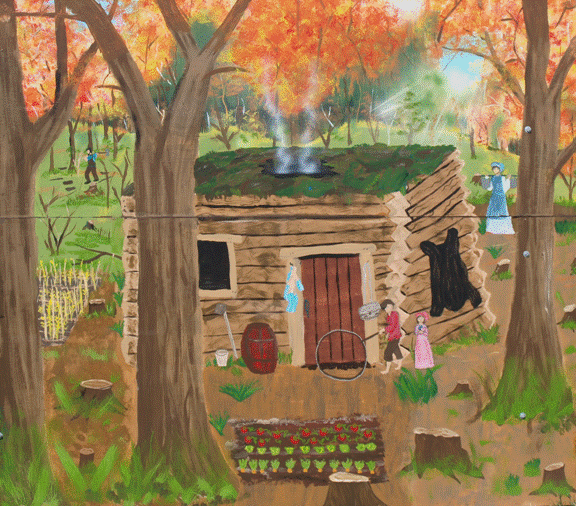
A Humble Forest Home
Late October 1810
Artists: Jessica Keaton,
Jessica Schroeder, Claudia Willis
This scene shows a new farm on the ridge. These farms were narrow holes carved
into a tall dense forest. Usually little sunlight would reach the ground in these situations.
But tall trees did not grow in the swamps which lined the south edge of these ridges.
These openings allowed some extra sunlight to reach their sun-hungry crops in midday.
When the young families arrived in Rootstown (to be renamed Ridgeville in 1813),
they found completed cabins in which to spend the winter. Some crops had already
been harvested, while winter crops were growing.
Their humble homes in the forest were crude substitutes for the fine frame homes they
had left back in Connecticut. These new cabins had dirt floors, except for two planks
used to support their bedsteads. They had no fireplaces, only open fire pits in the middle.
Holes left in the roofs channeled away the smoke. The holes also gave a fascinating view
of the trees and, in winter, the stars overhead.
Standing water and lazy creeks were unfit for drinking. But springs of clear ground-
filtered water emerged on the north sides of the ridges. Water had to be carried in
from the spring regularly. Indoor plumbing and bathrooms were still things far in the future.
The flat lands with subtle ridges lacked the charm of their familiar New England hills. But
flat land was a welcomed change to the farmers accustomed to rocky slopes. Though
cluttered with stumps that would take decades to remove, the soil was indeed deep
and fertile, as promised.
By one generation later, the region would host many large productive farms with
handsome framed houses.
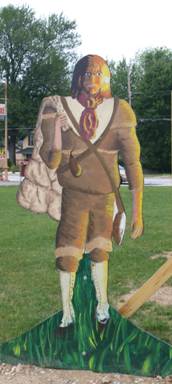
A Young Pioneer Brings Food
(A separate figure)
Artist: Colton Ulrich
A young pioneer of the Western Reserve goes off on an errand to carry potatoes,
perhaps to a neighbor in need.
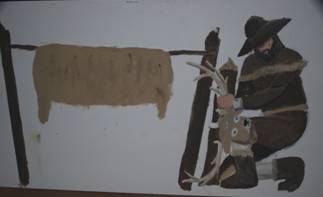
The Deer Skinner
(A separate figure to be added later)
Artist: José Leal
Hunting was a primary subsistence activity and hides were valuable. Note the curve-
bladed skinner knife, shaped to remove hides, showing just behind the deer’s head.
Buckskins were valued at one dollar; hence the slang term “buck” became used to
mean a “dollar.”
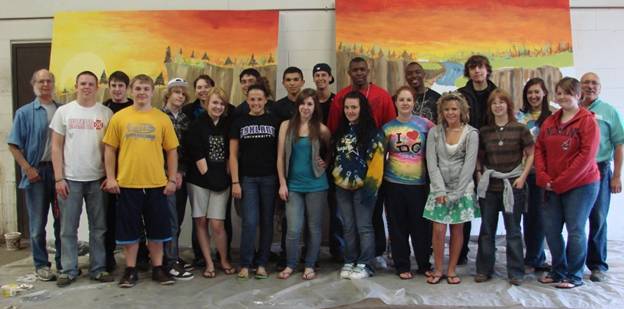
The Ridgeville History Mural Art Team
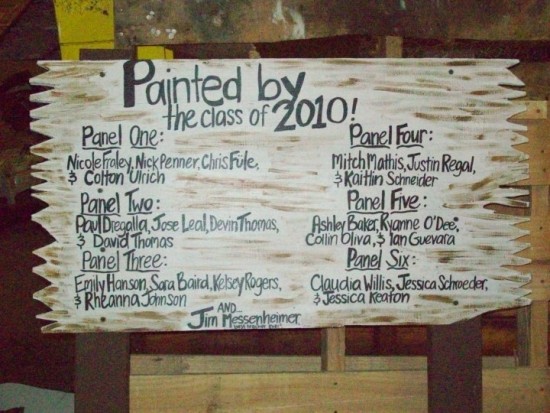
Back to main page
